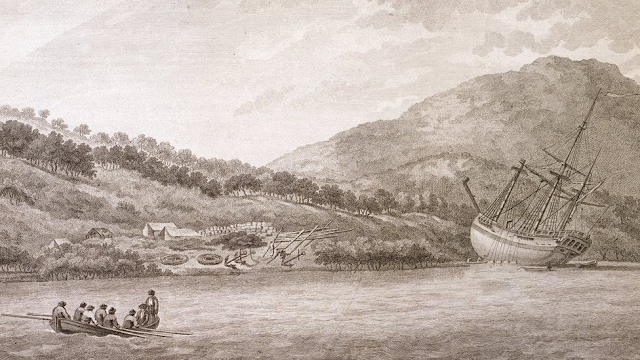The remains of the 'Endeavour' have been identified and found but arguments continue .....
I thought this account of my sailing on the replica of his vessel the Endeavour many years ago might be of interest. It is taken from the opening chapter of my book on the island provinces of Papua New Guinea entitled Beyond the Coral Sea : Travels in the Old Empires of the South-West Pacific (HarperCollins, London 2003). The book was short-listed for the Thomas Cook Travel Book Award.


The original idea of sailing a copra schooner called Barracuda around the islands of Eastern Papua New Guinea in the spirit of Robert Louis Stevenson had faded, as do so many boyhood dreams. I had always wanted to experience what it was like to sail the old vessels of the past on those remarkable voyages of discovery. My friends at the Royal Papua Yacht Club laughed at the idea and told me that all the old ketches and schooners had rotted in the mud. The price of copra had collapsed and the corpse of the industry was twitching. No-one would dream of wasting money building or even repairing an old copra schooner. There were no more sailing ships plying the islands. Traditional sailing canoes like the majestic lakatoi of Port Moresby Thursday Island in the far north of Australia New Guinea Port Moresby Mt. Hagen Highlands . I was disappointed, but determined to sail at least part of the Australian coastline in the old style, completely dependent on the vagaries of wind and weather.
A rare opportunity arose to ‘take passage’ on the replica of Captain Cook’s ship Endeavour as a supernumerary member of the crew. That it was sailing in precisely the opposite direction to my intended destination did not disturb me. I would experience sailing a tall ship along the New South Wales coast for a week from Southport (near Brisbane) to Sydney. A suitably nautical frame of mind would then enable me to jet off to Port Moresby
Endeavour is a handsome vessel and a magnificent Australian replica of the original ship. It was constructed as Australia Western Australia
Joseph Banks was only twenty-five when word reached him on 15 August 1768 that Endeavour was ready to take him aboard on a great adventure to the South Seas . He was at the opera in London London Plymouth
Banks’s father was an MP and the family were wealthy and well-connected, living at Revesby Abbey in Lincolnshire Eton (which trained him no doubt for the rigours of the voyage but not for the travails of love), spent seven years at Oxford British Museum London Tahiti as a place of observation, and James Cook was appointed chief observer of the transit. He selected a Whitby
As a Fellow of the Royal Society, Banks contributed ten thousand pounds to purchase a vast quantity of both practical and elegant equipment for the voyage, and transported a comprehensive library of some one hundred and fifty volumes. A party of nine made up his gentleman’s entourage, all trained in the techniques of collecting and preparing specimens. He became almost more famous than Cook himself, but remained dogged by the unfortunate repercussions of the ‘caddishly abandoned’ Miss Blosset (‘Miss Bl: swooned & etc’ his journal coolly observes ).
Cook had a complement of some 94 souls together with chickens, pigs, a cat and a milch goat that had already circumnavigated the globe. Dr. Johnson wrote a Latin motto for the celebrated animal
Perpetua ambita bis terra praemia lactis
Haec habet altrici Capra secunda Jovis [2]
By 16 August 1770, Cook had reached the Great Barrier Reef, courageously searching for the elusive passage between New Guinea Australia Spain
On 27 August they set sail for New Guinea Tahiti where the officers had observed the transit of Venus and Mr. Banks the slow and painful tattooing of a girl’s bottom. Two days later they came to a landfall fringed by dense vegetation and mangrove swamps. Banks wrote: ‘ Distant as the land was a very Fragrant smell came off from it realy in the morn with the little breeze which blew right off shore…..’ The water was warm, muddy and shallow, keeping them away from the coast until 3 September when they waded in to land. Banks collected a few specimens but remained curiously unimpressed. They found human footprints which caused them as much consternation as that felt by Robinson Crusoe. They proceeded with caution until they came to a hut in a grove of coconut palms. Three warriors suddenly rushed them from the jungle, throwing spears and incendiary devices, shouting hideously. A hundred naked Papuans appeared around a promontory. It was time to leave.
I transcribe a few entries from my voyage diary:
Endeavour, 7.30pm
4 September, 2000
Have come off Afternoon Watch and had dinner. A nerve-wracking and terrifying day. Rose early 6.00am . Troubled sleep – excitement, nerves and information overload. Claustrophobia with the cabin door shut. Prolix talk of ‘bunts’ ‘clews’ ‘belaying lines’ ‘bracing the yards’ and generally hauling on any of the innumerable ropes in sight. Mind-snapping terms of the sea is assumed knowledge – understood absolutely nothing.
Time to ‘go aloft’. Terrified. My group designated Foremast Watch. Forced by bravado to climb the ‘ratlines’. Felt decidedly like a rat. The lines are angled up to a platform called the ‘tops’. Remainder of the thirty-three metre mast towers above. Palms sweating. Shuffling along the yard (to which sails are furled) on rope not much thicker than a garden hose. ‘Stepping on!’ is the brisk instruction. ‘Falling off!’ screamed as you crash to the deck. Managed that then. Is this my future for the next seven days? Much preparation casting off. Very calm day, brilliant sunshine with light NE wind.
‘Stand by for cannon!’ shouts the ship’s carpenter, a handsome, blonde Cornishman, responsible for construction of the replica and loved by all the girls.
‘Fire in the hole!’ He lights the powder.
Boom! Replica four-pounder carriage gun recoils, acrid smoke rolls across the deck.
A terrific report, too close to some nautical types sipping Pimms on the deck of their chromium cruiser. They fell backwards off their chairs as shredded paper and smoke engulfed them.
‘Haul on the halyards! Ease on the bunts and clews!’
Felt like easing myself but not permitted until further out. Hauled on lines until palms sore. Not seasick but a visit to the heads (mariners’ term for onboard toilet) could bring it on. Open grey valve, pump up water, do your business, keep your balance as you have a good look while you pump out, repeat three times, close grey valve under pain of castration. Voyage will be no picnic. Comforting smell of tar.
Came off Afternoon Watch at 4.00pm and resume First Watch at 8.00pm . Ship glides slowly and is deeply restful. In perfect harmony with the sea. Progress about 3 knots – a stately speed which would have given Banks and his party ample time to draw, read, discuss and describe their collections. Sun setting through the stern sash windows of the Great Cabbin. Storm lanterns lit, secretive plashing of water at the stern and creaking of the ship. Absolutely magical and poetic.
Sailing at night on the Endeavour is like taking part in a Wagnerian opera, the Flying Dutchman perhaps. On watch, time to gaze up at the moon through the swaying rigging, silhouetted against the myriad stars of southern latitudes. A shadowy helmsman guides us across the deep. Silence on deck. Ship groans quietly as it folds through the sea. Watching the phosphorescence at the bow I was suddenly transfixed by the appearance of silver tunnels and comet trails cut by porpoises as they dodged and played before the ship. Captain ordered us to ‘wear ship’ - rudely broken reverie. Had to set the sails and belay lines (fasten the coils of rope around wooden pins) in the dark. After stress and furious activity, lying on my back in front of the helm watching the masts arch like giant pointers across the constellations. Dreamed of the discovery of New Guinea
Endeavour
6 September, 2000
Morning Watch began at 4.00am . Ungodly hour to be on deck. A still night with feathery winds and countless stars, the moon intensely bright. Silhouettes of the crew on watch float like wraiths. Dawn a glowing rind of orange before sun breaks the horizon. Red Ensign flies from the stern mast and stern lantern glints in the dawn.
Later in the morning a hump-backed whale breached - spectacular arch of patent-leather black and white. Barometer falling. ‘It’s coming alright’ crackled Captain Blake ominously on the weather deck. During night watches he often comes on deck bare-chested in a maroon sarong. Seems to sense any unnatural movement of the ship through his sleep. Catapaults from the companion to bark orders in 18th century style.
Mainmast Watch took in sail at Trial Bay New South Wales
Endeavour
7 September, 2000
Oppressive lowering sky and ominous calm. Hardly slept for last three days. On watch and took the ‘brains’ side of the wheel.1 Wind strength increased towards evening, gusting to 40 knots. Bow ploughed into the 1.5m swell but the ship felt strong. Sea a magnificent expanse of breaking waves, wind tearing the lashing foam. Shrieks rent the rigging. Wheel duty in this weather madly exhilarating. Maintaining course fraught with problems, arms aching, slow response to helm. Bow rises to frightening heights before ploughing back down into the troughs.
Lines lashed. Many seasick. Going aloft twenty-five metres in these conditions to take in t’gallant sails not for the fainthearted. Respect for the old mariners boundless – their achievement unimaginable until you sail a tall ship. Vessel utterly at the mercy of wind. So tired cannot sleep. Eating little.
‘Great Cabbin’ Endeavour
8 September, 2000
Physically impossible to write. Force 8 gales. Taking in all sail. On verge of throwing up. Gorge rising. Ship lurched and shuddered through night. Roped myself into the fixed cot.
Endeavour
9 September, 2000
Wind sufficiently abated to write a journal entry. Warm sun as we sail along the coast of New South Wales
‘Hauling on the halyards! Easing on the bunts and clews! Bracing the yards!’
‘Two, six….heave!’ we hauled on the lines.
‘Two, six….heave!’
‘Belay all lines’ Sighs of relief.
Leaned against the capstan and idly looked at a jetliner high above, slicing across the sky leaving a glittering trail of ice crystals; the 18th century contemplating the 21st century. The original exploration of the Black Islands New Guinea
1 The English north-country vessel known as a ‘cat’ was a Whitby
2 Two seamen are normally at the wheel – the ‘muscles’ on the port side who only helps turn it and the ‘brains’ on the starboard side who turns and maintains the course, calling out the setting and watching the instruments.
Beyond the Coral Sea : Travels in the Old Empires of the South-West Pacific (HarperCollins, London 2003).
http://www.michael-moran.net/pages/books/beyond_the_coral_sea/index.htm
http://www.michael-moran.net/pages/books/beyond_the_coral_sea/index.htm




Comments
Post a Comment